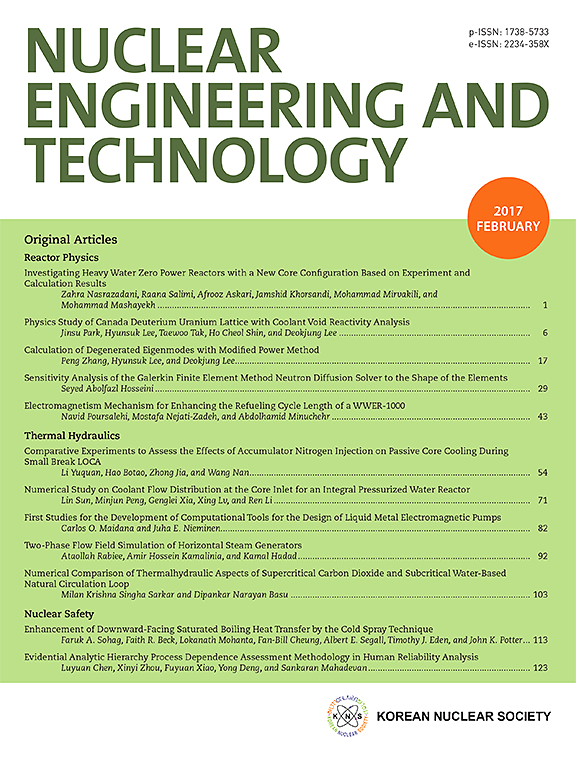初级辐射损伤模型和SRIM模拟的进展:辐射损伤预测综述
IF 2.6
3区 工程技术
Q1 NUCLEAR SCIENCE & TECHNOLOGY
引用次数: 0
摘要
评估材料和器件的辐射损伤对于其在极端环境中的使用至关重要,但由于传统模型(如初级辐射损伤模型(prdm))和现代模拟(如物质中离子的停止和范围(SRIM))的不确定性,准确的预测具有挑战性。本文综述了辐射损伤预测的主要方法,包括Kinchin-Pease (K-P)、Norgett-Robinson-Torrens dpa (NRT-dpa)、非热复合校正dpa (arc-dpa)、每原子置换dpa (rpa-dpa)和Chen-Bernard dpa (CB-dpa)模型。它强调了非热复合、经验验证和实际应用的重要性。讨论了SRIM的约束,强调了在全级联(F-C)和快速计算(Q-C)模式下Lindhard, Scharff和Schiott (LSS)停止功率和能量转移过程中的不准确性。总结了阈值位移能、电子停止功率、密度和结合能等关键因素。最后,对本文的主要研究成果进行了展望。本文综述了辐射损伤建模的现状,为核能、航空航天和其他辐射相关领域的应用提供了指导。本文章由计算机程序翻译,如有差异,请以英文原文为准。

Advancements in primary radiation damage models and SRIM simulations: A review of radiation damage predictions
Evaluating radiation damage in materials and devices is vital for their use in extreme environments, but accurate predictions are challenging due to uncertainties in traditional models like Primary Radiation Damage Models (PRDMs) and modern simulations such as Stopping and Range of Ions in Matter (SRIM). This paper reviews essential methodologies for predicting radiation damage, including the Kinchin-Pease (K-P), Norgett-Robinson-Torrens dpa (NRT-dpa), athermal recombination corrected dpa (arc-dpa), replacement per atom dpa (rpa-dpa), and Chen-Bernard dpa (CB-dpa) models. It underscores the importance of athermal recombination, empirical validations, and practical applications. The constraints of SRIM are discussed, emphasizing the inaccuracies in the Lindhard, Scharff, and Schiott (LSS) stopping powers and energy transfer processes in Full Cascade (F-C) and Quick Calculation (Q-C) modes. Key factors like threshold displacement energy, electronic stopping powers, density, and binding energy are also summarized. Finally, the key findings and prospects for future research are presented. This review offers insights into the current state of radiation damage modeling, providing guidance for applications in nuclear, aerospace, and other radiation-related fields.
求助全文
通过发布文献求助,成功后即可免费获取论文全文。
去求助
来源期刊

Nuclear Engineering and Technology
工程技术-核科学技术
CiteScore
4.80
自引率
7.40%
发文量
431
审稿时长
3.5 months
期刊介绍:
Nuclear Engineering and Technology (NET), an international journal of the Korean Nuclear Society (KNS), publishes peer-reviewed papers on original research, ideas and developments in all areas of the field of nuclear science and technology. NET bimonthly publishes original articles, reviews, and technical notes. The journal is listed in the Science Citation Index Expanded (SCIE) of Thomson Reuters.
NET covers all fields for peaceful utilization of nuclear energy and radiation as follows:
1) Reactor Physics
2) Thermal Hydraulics
3) Nuclear Safety
4) Nuclear I&C
5) Nuclear Physics, Fusion, and Laser Technology
6) Nuclear Fuel Cycle and Radioactive Waste Management
7) Nuclear Fuel and Reactor Materials
8) Radiation Application
9) Radiation Protection
10) Nuclear Structural Analysis and Plant Management & Maintenance
11) Nuclear Policy, Economics, and Human Resource Development
 求助内容:
求助内容: 应助结果提醒方式:
应助结果提醒方式:


